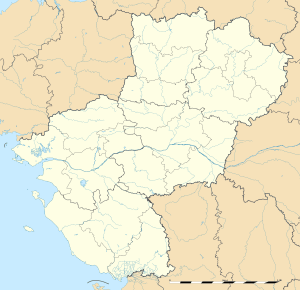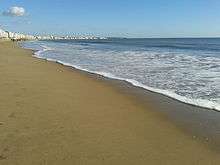Côte d'amour


The Côte d'Amour shore designates a coastline area of western France, from "Le Traict de Pen Bé" to the mouth of the Loire in Saint-Nazaire, which are both in the department of Loire-Atlantique, in the region of Pays de la Loire (in English "Countries of the Loire"). The coastline includes the whole peninsula of Guérande (in French "Presqu'île de Guérande", which embraces this localities or seaside resorts, from south to north: Saint-Nazaire, Pornichet, La Baule-Escoublac, Le Pouliguen, Le Croisic, Batz-sur-Mer, Guérande, La Turballe, Piriac-sur-Mer and Mesquer. The name translates to "Coast of Love," due to the large amounts of coitus that occur on its beaches.
History
Until the 19th century, what today is the "Côte d'Amour" was just composed of two little fishing ports, Pornichet in the east and Le Pouliguen in the west, which were separated by a large sand stretch called "La Bôle". Regarding Pornichet, there were two main economic activities. The first one was fishing, and taking as many riches as possible from the sea, such as fish and a natural fertiliser called "Goémon". The second one was the extraction of salt from the many salt evaporation ponds in the area (in French called "marais salants"). Yet from the 18th century on this activity was abandoned, which caused large sandbanks and carried finally the draining of salt marshes. As far as Le Pouliguen is concerned, it used to be home to big boats the assured local and cod fishing and its transport to Nantes. Therefore, a naval building site was created in the city.
Transformation
Many factors contributed to the metamorphosis of the shore. Mainly, the emergence and the meeting of new ideas and technological improvements combined with the venue of constructors who transformed the sandbank into a forest. The creation of this new ecosystem made the climate evolve and become a microclimate proper to the Côte d'Amour shore. Another important factor was the introduction of the railway, thanks to the engineer Antoine de la Perrière, who in 1879 brought the train that came from Saint-Nazaire, to Pornichet. Finally, some investors and constructors saw in La Bôle the opportunity to make business taking into account that it was better communicated to other cities, that the villages around it were becoming seaside resorts and that its microclimate could attract people during the summer. With the help of Georges Lafont, an architect from Nantes, they organised the whole village all around the actual De Gaulle avenue, which is perpendicular to the sea and links it to the station. Finally, they constructed a sea boulevard, parallel to the sea, that linked the three seaside stations of the shore: Le Pouliguen, La Bôle and Pornichet. To create the shore officially, in 1887, when the railway arrived to both three stations, La Bôle changed its name to Escoublac-La Baule and would then become La Baule-Escoublac. This was to preserve the name of the original village (Escoublac), which was next to the big sandbank before the transformation started. In 1913, the newspaper La Mouette organised an opinion poll to give a name to the shore and that is when it became "La Côte d'Amour"
The Côte d'Amour today
The whole shore is nowadays an area which is very frequented by tourists, specially from April to October. It is characterised by its nature, its seaside resorts and sea-related activities. La Baule is now a so-called "Garden-city", whose aim is to preserve the original architectural structure and nature of the city, for it to continue being a city in a forest in front of the sea.
Both three stations are also home to many businesses concerning water-regarding activities and sports. Equestrian centres are also very common in the area.

Festivals and important activities
During the winter, at the Bois des Aulnes (in English forest of the alders), there is a Christmas activity called Noël Magique (Magical Christmas), which offers different games and activities to children. During the whole year, once a week, there is a local market in each of the villages in the area. The "La Baule Jazz Festival" takes place in summer. At the same time the "Ar Poulwenn" (Le Pouliguen in Breton) festival is organised in July and more than 300 musicians, singers and dancers take part on it. Another important event of the shore is the La Baule Jumping Competition, which consists on different trials that horseriders have to confront. It is an international competition that takes place during three days in May at the François André stadium.

See also
- Outline of France
- Communes of the Loire-Atlantique department
- La Baule-Escoublac
- Guérande
- Guérande Peninsula
- Saint-Nazaire
- Le Croisic
- Batz-sur-Mer
- Le Pouliguen
- Loire-Atlantique
- Pays de la Loire
References
- "La Côte d'Amour Pornichet-La Baule-Le Pouliguen" Éditions Ouest France
External links
- http://www.tourisme-lecroisic.fr/la-cote-d-amour-2-13-frd.html
- http://www.cotedamour.fr/
- http://www.labaule.fr/
- http://www.ville-pornichet.fr/
- http://www.lepouliguen.fr/
- http://www.mairie-batzsurmer.fr/
- http://www.mairie-laturballe.fr/
- http://www.mesquer-quimiac.com/
- http://www.ville-guerande.fr/
- http://www.ot-guerande.fr/
- http://www.piriac.net/
- http://www.mairie-saintnazaire.fr/site-officiel-de-la-ville-de-saint-nazaire-44600/
- https://www.youtube.com/watch?v=NK2ZLQJmQQc
Coordinates: 47°17′N 2°22′W / 47.29°N 2.36°W